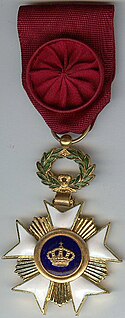Order of the Crown (Belgium)
| Order of the Crown | |
|---|---|

Officer of the Order of the Crown (obverse)
|
|
| Awarded by |
|
| Type | Order of Merit with five classes, plus two palms and three medals |
| Motto |
TRAVAIL ET PROGRES - ARBEID EN VOORUITGANG |
| Day | Awarded on 8 April (Birthday of King Albert I) and 15 November (King's Feast), and for obliging cases on 21 July (Belgian national holiday). |
| Eligibility | Eligible for persons above the age of 42 |
| Awarded for | Meritorious service to the Belgian state |
| Status | Currently constituted |
| Sovereign | His Majesty King Philippe |
| Grades | Grand Cross Grand Officer Commander Officer Knight |
| Statistics | |
| Established | 15 October 1897 1897 - 1908 (Order of Congo) 1908 - present (as Belgian Order) |
| Precedence | |
| Next (higher) | Royal Order of the Lion |
| Next (lower) | Order of Leopold II |
The Order of the Crown (French: Ordre de la Couronne, Dutch: Kroonorde) is a national order of the Kingdom of Belgium. It is considered in diplomatic traffic as a gift of very high value.
Th Order was established on October 15, 1897 by King Leopold II in his capacity as ruler of the Congo Free State. The order was first intended to recognize heroic deeds and distinguished service achieved for service in the Congo Free State—many of which acts soon became highly controversial. In 1908, the Order of the Crown was made a national decoration of Belgium, junior to the Order of Leopold.
Currently, the Order of the Crown is awarded for services rendered to the Belgian state, especially for meritorious service in public employment. The Order of the Crown is also awarded for distinguished artistic, literary or scientific achievements, or for commercial or industrial services in Belgium or Africa.
The Order may also be bestowed to foreign nationals and is frequently awarded to military and diplomatic personnel of other countries stationed in (or providing support to) Belgium. During the Second World War, the Order of the Crown was extensively authorized for award to Allied military personnel who had helped to liberate Belgium from the occupation forces of Nazi Germany.
The Order of the Crown is awarded by royal decree.
The Order of the Crown is awarded in five classes, plus two palms and three medals:
The badge of the Order is a white-enamelled Maltese cross with straight rays, in silver for the Knight class and in gold for the higher classes. The obverse central disc has a gold crown on a blue enamelled background; the reverse central disc has the face-to-face monogram "L" (for King Leopold II) on a blue enamelled background. The badge is suspended from a green-enamelled wreath of laurel and oak leaves.
...
Wikipedia
